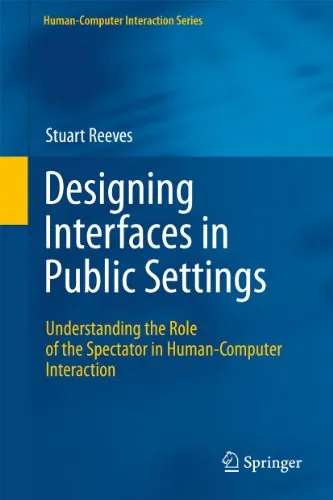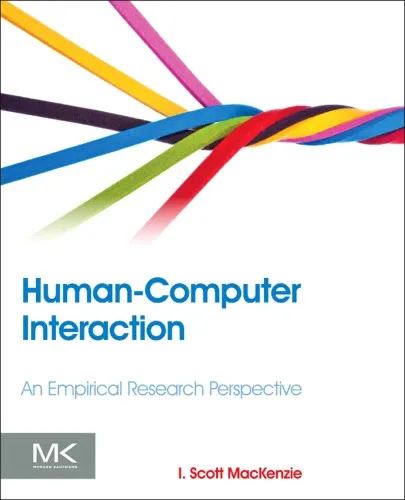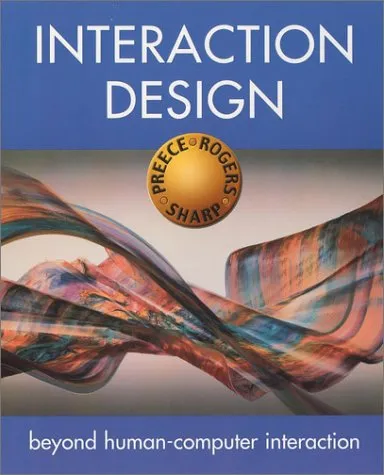Designing Interfaces in Public Settings: Understanding the Role of the Spectator in Human-Computer Interaction
4.5
بر اساس نظر کاربران

شما میتونید سوالاتتون در باره کتاب رو از هوش مصنوعیش بعد از ورود بپرسید
هر دانلود یا پرسش از هوش مصنوعی 2 امتیاز لازم دارد، برای بدست آوردن امتیاز رایگان، به صفحه ی راهنمای امتیازات سر بزنید و یک سری کار ارزشمند انجام بدینکتاب های مرتبط:
معرفی کتاب
کتاب 'Designing Interfaces in Public Settings: Understanding the Role of the Spectator in Human-Computer Interaction' نوشته استوارت ریوز به بررسی نقش تماشاگران در تعاملات بین انسان و کامپیوتر میپردازد. این کتاب به اهمیت طراحی Interfaceها در فضاهای عمومی تاکید دارد و توضیح میدهد که چگونه میتوان این تعاملات را به نحو احسن به کار گرفت.
خلاصهای از کتاب
این کتاب به شما کمک خواهد کرد تا مفهوم Spectator را در زمینۀ Human-Computer Interaction (HCI) به خوبی درک کنید. ریوز در تمام فصول نشان میدهد که چگونه Spectatorها نقش کلیدی در پویایی تعاملات اجتماعی در فضاهای عمومی دارند. او با استفاده از مطالعات موردی و تحقیقات تجربی، به بررسی چگونگی طراحی Interfaceهایی برای جلب توجه و همکاری تماشاگران میپردازد.
نکات کلیدی
- اهمیت طراحی برای Spectator: چگونه حضور Spectator میتواند میزان تعامل کاربران با کامپیوتر را افزایش دهد.
- تجربیات عملی: مثالها و تحقیقات واقعی که نشان میدهند چگونه تعاملات HCI در فضاهای عمومی تغییر میکنند.
- راهبردهای طراحی Interface: روشهای مؤثر برای جلب نظر و درگیر کردن تماشاگران در تعاملات عمومی.
جملات معروف از کتاب
"تماشاگران نه تنها مشاهدهگران منفعل بلکه شرکتکنندگان فعال در نمایش تعاملات انسانی و کامپیوتری هستند."
"به جای طراحی برای کاربرانی که از قبل در سیستم تعریف شدهاند، طراحی باید تماشاگرانی که ممکن است به تعامل کشیده شوند را نیز در نظر بگیرد."
چرا این کتاب مهم است
در عصر حاضر که تکنولوژی به سرعت در حال پیشرفت است، فهمیدن نقش Spectatorها در HCI میتواند به ما در طراحی بهتر و مؤثرتر کمک کند. ریوز با ارائه تحلیلهای جامع و کاربردی، نشان میدهد که چگونه میتوان از تعاملات اجتماعی و روانشناختی بهره برد تا طراحیهای منحصربهفردتری ایجاد کنیم. این کتاب میتواند برای طراحان رابط کاربری، دانشجویان و پژوهشگران در زمینه HCI و هرکسی که به تعاملات انسانی در محیطهای تکنولوژیمحور علاقه دارد، بسیار مفید باشد.
Welcome to a comprehensive exploration of the fascinating intersection between spectatorship and interaction design in public settings. "Designing Interfaces in Public Settings: Understanding the Role of the Spectator in Human-Computer Interaction" delves into the nuanced ways by which individuals engage with digital interfaces not as solitary users but as part of a broader audience.
Detailed Summary of the Book
This book ventures into the less-trodden path of examining the role of the spectator in human-computer interaction (HCI). Often, interface design considers the user as a solitary entity, but in public settings, the reality is quite different. Whether it be interactive installations, digital signage, or public kiosks, these interfaces are frequently experienced in a communal environment. The book provides an analytical framework for understanding how interfaces can be designed to accommodate and even leverage the presence of spectators.
Spanning various contexts and case studies, this book covers the multiple facets of interaction in public settings. It contrasts these with private interactions to highlight the unique challenges and opportunities present in designing for the public. The narrative is grounded in real-world research and examples, providing practical insights for designers and researchers aiming to create more inclusive and engaging public interfaces.
Key Takeaways
- The importance of acknowledging and designing for the presence of spectators in public interactions.
- Approaches to designing interfaces that are inclusive and engaging, maximizing both usability and user experience.
- A comprehensive understanding of the dynamics at play when multiple users engage with a single interactive interface.
- Practical case studies that provide real-world applications and implications for public interface design.
Famous Quotes from the Book
"In public settings, an interface is never simply an isolated experience; it flows into and out of the broader social context in which it resides."
"The spectator's role is not merely passive observation but becomes an active, albeit indirect, component of interactive systems."
Why This Book Matters
The domain of HCI is traditionally skewed towards individual user experiences, often overlooking the diverse contexts in which interactions occur. However, public interfaces are becoming more ubiquitous, from interactive art installations to digital kiosks in shopping malls, and their success hinges on understanding the dynamics of public interaction. This book is crucial for academics, designers, and practitioners who want to transcend conventional interaction paradigms and venture into comprehensive design strategies that consider both the individual user and the surrounding spectators.
By dissecting the spectator’s role, the book spotlights an essential yet underexplored dimension of digital interaction. The insights provided not only enhance our understanding of user experience in public settings but also pave the way for more intuitive and collectively interactive public environments.
دانلود رایگان مستقیم
شما میتونید سوالاتتون در باره کتاب رو از هوش مصنوعیش بعد از ورود بپرسید
دسترسی به کتابها از طریق پلتفرمهای قانونی و کتابخانههای عمومی نه تنها از حقوق نویسندگان و ناشران حمایت میکند، بلکه به پایداری فرهنگ کتابخوانی نیز کمک میرساند. پیش از دانلود، لحظهای به بررسی این گزینهها فکر کنید.
این کتاب رو در پلتفرم های دیگه ببینید
WorldCat به شما کمک میکنه تا کتاب ها رو در کتابخانه های سراسر دنیا پیدا کنید
امتیازها، نظرات تخصصی و صحبت ها درباره کتاب را در Goodreads ببینید
کتابهای کمیاب یا دست دوم را در AbeBooks پیدا کنید و بخرید
1506
بازدید4.5
امتیاز0
نظر98%
رضایتنظرات:
4.5
بر اساس 0 نظر کاربران
Questions & Answers
Ask questions about this book or help others by answering
No questions yet. Be the first to ask!







